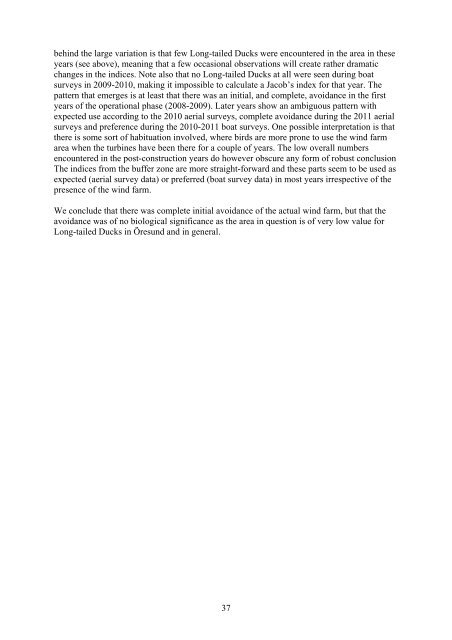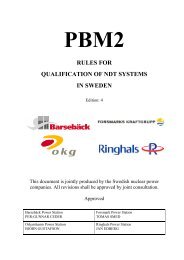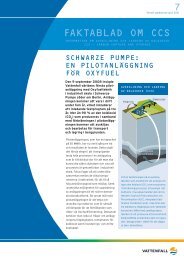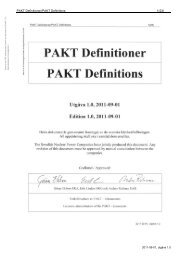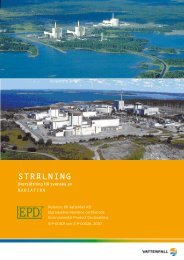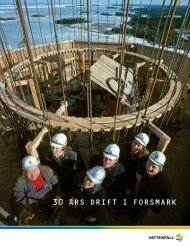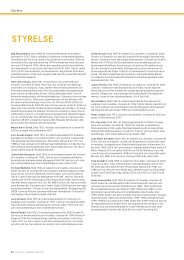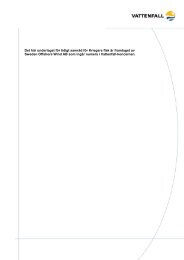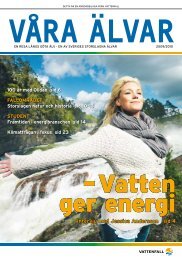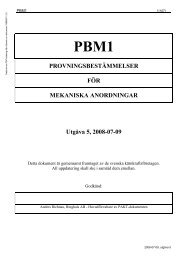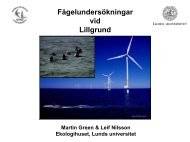Birds in southern Öresund in relation to the wind farm at ... - Vattenfall
Birds in southern Öresund in relation to the wind farm at ... - Vattenfall
Birds in southern Öresund in relation to the wind farm at ... - Vattenfall
You also want an ePaper? Increase the reach of your titles
YUMPU automatically turns print PDFs into web optimized ePapers that Google loves.
eh<strong>in</strong>d <strong>the</strong> large vari<strong>at</strong>ion is th<strong>at</strong> few Long-tailed Ducks were encountered <strong>in</strong> <strong>the</strong> area <strong>in</strong> <strong>the</strong>se<br />
years (see above), mean<strong>in</strong>g th<strong>at</strong> a few occasional observ<strong>at</strong>ions will cre<strong>at</strong>e ra<strong>the</strong>r dram<strong>at</strong>ic<br />
changes <strong>in</strong> <strong>the</strong> <strong>in</strong>dices. Note also th<strong>at</strong> no Long-tailed Ducks <strong>at</strong> all were seen dur<strong>in</strong>g bo<strong>at</strong><br />
surveys <strong>in</strong> 2009-2010, mak<strong>in</strong>g it impossible <strong>to</strong> calcul<strong>at</strong>e a Jacob’s <strong>in</strong>dex for th<strong>at</strong> year. The<br />
p<strong>at</strong>tern th<strong>at</strong> emerges is <strong>at</strong> least th<strong>at</strong> <strong>the</strong>re was an <strong>in</strong>itial, and complete, avoidance <strong>in</strong> <strong>the</strong> first<br />
years of <strong>the</strong> oper<strong>at</strong>ional phase (2008-2009). L<strong>at</strong>er years show an ambiguous p<strong>at</strong>tern with<br />
expected use accord<strong>in</strong>g <strong>to</strong> <strong>the</strong> 2010 aerial surveys, complete avoidance dur<strong>in</strong>g <strong>the</strong> 2011 aerial<br />
surveys and preference dur<strong>in</strong>g <strong>the</strong> 2010-2011 bo<strong>at</strong> surveys. One possible <strong>in</strong>terpret<strong>at</strong>ion is th<strong>at</strong><br />
<strong>the</strong>re is some sort of habitu<strong>at</strong>ion <strong>in</strong>volved, where birds are more prone <strong>to</strong> use <strong>the</strong> w<strong>in</strong>d <strong>farm</strong><br />
area when <strong>the</strong> turb<strong>in</strong>es have been <strong>the</strong>re for a couple of years. The low overall numbers<br />
encountered <strong>in</strong> <strong>the</strong> post-construction years do however obscure any form of robust conclusion<br />
The <strong>in</strong>dices from <strong>the</strong> buffer zone are more straight-forward and <strong>the</strong>se parts seem <strong>to</strong> be used as<br />
expected (aerial survey d<strong>at</strong>a) or preferred (bo<strong>at</strong> survey d<strong>at</strong>a) <strong>in</strong> most years irrespective of <strong>the</strong><br />
presence of <strong>the</strong> w<strong>in</strong>d <strong>farm</strong>.<br />
We conclude th<strong>at</strong> <strong>the</strong>re was complete <strong>in</strong>itial avoidance of <strong>the</strong> actual w<strong>in</strong>d <strong>farm</strong>, but th<strong>at</strong> <strong>the</strong><br />
avoidance was of no biological significance as <strong>the</strong> area <strong>in</strong> question is of very low value for<br />
Long-tailed Ducks <strong>in</strong> <strong>Öresund</strong> and <strong>in</strong> general.<br />
37


